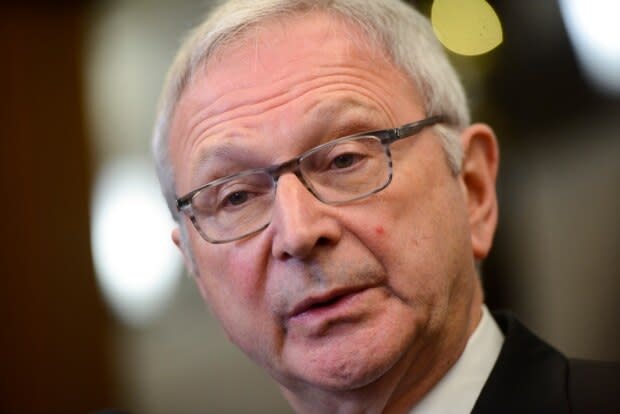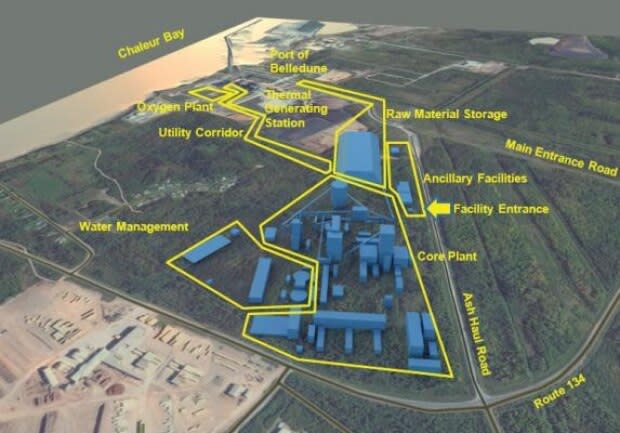Higgs says Maritime Iron plant hinges on a federal exemption — an exemption that doesn't exist
Maritime Iron's hopes of winning provincial approval for its proposed high-emissions iron plant appear to hinge on a federal exemption mechanism that doesn't exist.
Premier Blaine Higgs said Ottawa giving the plant a special pass will "absolutely be the decision-maker" in whether it will be allowed to add 2.3 million tonnes of greenhouse gases to New Brunswick's emissions.
Higgs said if the federal government recognizes that the plant will reduce emissions globally even while increasing them provincially, "we should be good to go," citing what he said was a similar exemption given to a liquefied natural gas plant in British Columbia.
He said his government has been working with the federal government on that possibility.
But the B.C. plant has not received any such federal exemption and there is no mechanism for Ottawa to grant one so a province can get around its own provincial emissions targets.

"The project at issue is going through an environmental assessment that is a provincial assessment," federal Environment Minister Jonathan Wilkinson said in Ottawa. "We expect that provinces are going to focus on how they actually meet their own emissions targets."
Maritime Iron claims the plant will displace higher-emitting iron processing plants in other countries and that its location will reduce shipping distances, cutting down on emissions from ocean freighters.
That will lead to a net global reduction in emissions even if New Brunswick's numbers go up, the company says.

Article 6 of the Paris climate agreement leaves the door open to countries sharing emissions reductions through transfers of reduction credits.
But countries wanting to do that would have to first agree on rules governing how to verify and measure such reductions. International negotiators failed to reach such an agreement at talks in Madrid in December.
Consider global impact, premier says
Higgs spoke to reporters last week after Maritime Iron's environmental impact assessment document was filed publicly with the province.
The document says if the new iron processing plan were linked to NB Power's adjacent Belledune generating station, the two facilities would emit a combined 4.9 million tonnes of greenhouse gases, a net increase of 2.3 million.
That would make it difficult for New Brunswick to hit both its legislated emissions target for 2020 and a less stringent reduction target for 2030 that is modelled on Canada's Paris agreement goals.
Higgs said the project could be in jeopardy if Ottawa doesn't recognize that the Belledune plant would displace existing Chinese iron processors.
"It will hinge on the federal government approving this project to be treated as a global emission reduction," Higgs said. "If they treat it in isolation for New Brunswick and don't give it an exemption, then that'll be an issue."
He pointed to a liquefied natural gas plant to be built in B.C. by a consortium called LNG Canada as a precedent.
"We're seeing in B.C. they've done the same thing, with the L.N.G. plant that's out in B.C.," he said. "That's treated as a global emission reduction."
No mechanism in place
But no such federal exemption exists for the B.C. plant because federal and provincial officials agree the plant won't exceed the province's targets.
"LNG Canada fits within the climate architecture of the B.C. government," Wilkinson said.
Last year, then-federal natural resources minister Amarjeet Sohi floated the idea that Article 6 of the Paris agreement could be used for the LNG plant.
But with no agreed-upon mechanism to measure the hypothetical emissions reductions elsewhere, it hasn't happened yet.
Ottawa doesn't even have a role in the Maritime Iron approval process and isn't responsible for whether it counts towards New Brunswick's provincially-legislated targets.
Higgs's office did not respond to a request Tuesday for documentation of the exemption he was talking about.
LNG Canada, the consortium building the plant in Kitimat, B.C., has claimed its methane gas could replace 20 to 40 coal-fired power plants in countries such as China and India, reducing emissions by 60 to 90 million tonnes.

B.C. Premier John Horgan has used that claim to justify approving the plant, claiming it will keep provincial emissions within limits set out in his government's climate plan — something environmentalists dispute.
Horgan has also promised the plant a break on the next increase in the provincial carbon tax, along with other subsidies, if it meets a standard for emissions intensity.
Proposal would create largest N.B. emitter
The combined 4.9 million tonnes of emissions from the combined Maritime Iron-NB Power facility would make it the biggest emitter of greenhouse gases in New Brunswick, far exceeding Irving Oil's annual output of around three million tonnes.
Maritime Iron has suggested that the province go looking for emissions reductions elsewhere to make room for its increase.
The province's legislated emissions goal for this year is 14.8 million tonnes, and for 2030 it's 10.7 million tonnes. It also has a second, less stringent 2030 goal, 14.1 million tonnes, tied to Canada's Paris climate plan objectives.
New Brunswick's emissions in 2017 were 14.3 million tonnes, below the legislated 2020 target and close to the 2030 Paris target.
The Belledune iron plant would employ 200 people during operations and 1,300 during a two-year construction phase.


